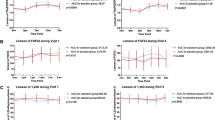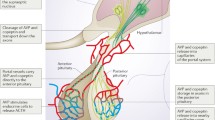Summary
In order to define the pharmacodynamic profile of salmon calcitonin (sCT) in humans, several markers of the biological activity of the drug have been studied, namely cAMP, adenosine and pO2 in venous blood, and the cytosolic free calcium level in circulating cells. Different dosages and routes of administration (1.5 IU. kg−1 and 0.75 IU kg−1 IM, and 1.5 IU. kg−1 via nasal spray) were compared.
sCT caused an increase in cAMP, adenosine and pO2, and a decrease in cytosolic free calcium in neutrophils, lymphocytes and platelets. The peak times of all these parameters ranged between 109 and 182 min, and 101 and 168 min after IM and nasal spray administration respectively. There was greater variability in the values after IM than nasal spray of administration of sCT.
It is concluded that adenosine and p02 in venous blood, and cytosolic free calcium in circulating cells are valuable markers of the activity of sCT and that sCT decreases the cytosolic free calcium level in neutrophils, lymphocytes and platelets. Pharmacodynamic analysis of the biological effects of the drug is highly reliable and valuable in predicting its pharmacological profile. sCT administration via a nasal spray is able to produce significant biological effects, although they are less marked than after IM dosing.
Similar content being viewed by others
References
MacIntyre I, Craig RK (1982) Molecular evolution of the calcitonins. In: Fink RG, Whalley LJ (eds) Neuropeptides: basic and clinical aspects. Proceedings of the 11th Pfizer International Symposium. September 1981. Churchill Livingstone, pp 255–258
Guttmann S (1981) Chemistry and structure-activity relationship of natural and synthetic calcitonin. In: Pecile A (ed) Calcitonin 1980. Proceedings International Symposium Milan 1980. Excerpta Medica Int Congr Ser 540: 11–24
Martin TJ, Robinson CJ, MacIntyre I (1966) The mode of action of thyrocalcitonin. Lancet 1: 900–902
Chambers TJ, Dunn CJ (1983) Pharmacological control of osteoclastic mobility. Calcif Tissue Int 35: 566–570
Azria M (1989) The calcitonins. Physiology and pharmacology. Karger, Basel, pp 1–152
Caniggia A, Gennari C (1987) Timing of the effects of bPTH (1–34), pCT and sCT on calcium and cAMP in man. Calcif Tissue Res suppl 2: 318–322
Gennari C, Chierichetti SM, Vibelli C, Francini G, Maioli E, Gonnelli S (1981) Acute effects of salmon, human and porcine calcitonin on plasma calcium and cyclic AMP levels in man. Curr Ther Res 30: 1024–1032
Berne RM (1985) Criteria for the involement of adenosine in the regulation of blood flow. In: Paton DM (ed) Methods in pharmacology, Plenum Press, New York, pp 331–336
Sparks HV Jr, Gorman MW (1987) Adenosine in the local regulation of blood flow: current controversies. In Gerlach E, Becker BF (eds) Topic and perspectives in adenosine research. Springer Berlin Heidelberg New York, pp 406–415
Perr HM, Kahn AJ, Chappel JC, Kohler G, Teitelbaum SL, Peck WA (1983) Calcitonin response in circulating human lymphocytes. Endocrinology 113: 1568–1573
Grynkievicz G, Poenie M, Tsien RY (1985) A new generation of Ca2+ indicators with greatly improved fluorescence properties. J Biol Chem 260: 3440–3450
Muir KT (1980) Non-linear least squares regression analysis in pharmacokinetics: application of a programmable calculator in model parameter estimation. Comput Biomed Res 13: 307–316
Singer FR, Rude RK, Mills BG (1976) Studies of the treatment and aetiology of Paget's disease of bone. In: MacIntyre I (ed) Human calcitonin and Paget's disease. Proceedings of an International Workshop, London, April 1976, Huber, Bern Stuttgart Toronto, pp 93–110
Vattimo et al. (unpublished data)
Shepherd AP, Riedel GL, Maxwell LC, Kiel JW (1984) Selective vasodilators redistribute intestinal blood flow and depress oxygen uptake. Am J Physiol 247: 377–384
Christopher YP, Choong C, Gary S, Roubin G, Wei-Feng Shen M, Phillip J, Harris P, Kelly D (1985) Effects of nifedipine on systemic and regional oxygen transport and metabolism at rest and during exercise. Circulation 71: 787–796
Daly JW (1982) Adenosine receptors: targets for future drugs. J Med Chem 25: 197–207
Laghi Pasini F, Capecchi PL, Orrico A, Ceccatelli L, Di Perri T (1985) Adenosine inhibits polymorphonuclear in vitro activation: a possible role as an endogenous calcium entry blocker. J Immunopharmacol 7: 203–215
Laghi Pasini F, Capecchi PL, Pasqui AL, Ceccatelli L, Di Perri T, Valensin G, Gaggelli E (1990) Adenosine blocks calcium entry into activated neutrophils and binds to flunarizine-sensitive calcium channels. Immunopharmacol Immunotoxicol 12: 77–93
Klabunde RE (1983) Dipyridamole inhibition of adenosine metabolism in human blood. Eur J Pharmacol 93: 21–26
Kishikawa T, Shimazawa E, Ogata E (1982) Involvement of calcium in calcitonin induced stimulation of glycolysis in rat kidney in situ. Endocrinol Japan 29: 149–157
Borle AB (1983) Calcitonin and the regulation of calcium transport and of cellular calcium metabolism. Triangle 2: 75–90
Koida M, Yamamoto Y, Nakamuta H, Matsuo J, Okamoto M, Morimoto T, Seyler JK, Orlowski RC (1982) A novel effect of salmon calcitonin on in vitro Ca-uptake by rat brain hypothalamus: the regional and hormonal specificities. Jap J Pharmacol 32: 981–986
Pecile A, Olgiati VR, Sibilia V (1983) Attività analgesica di calcitonina di diversa origine. In: Gennari C, Segre G (eds) The effects of calcitonin in man. Proceedings 1st International Workshop, Florence 1982, Masson Paris, pp 205–211
Murphy E, Chamberlin ME, Mandel LJ (1986) Effects of calcitonin on cytosolic Ca++ in a suspension of rabbit medullary thick ascending limb tubules. Am J Physiol 251: C491-C495
Yamaguchi M (1989) Effect of calcitonin on exchangeable calcium transport in isolated rat hepatocytes. Mol Cell Endocrinol 62: 313–318
Malgaroli A, Meldolesi J, Zamboni Zallone A, Teti A (1989) Control of cytosolic free calcium in rat and chicken osteoclasts. The role of extracellular calcium and calcitonin. J Biol Chem 264: 14342–14347
MacIntyre I (1988) The radioimmunoassay of calcitonin and the calcitonin gene peptide: relationship to the biological activity. In: Mazzuoli GF (ed) Calcitonin '88, Rome March 26–27 1988. Si Stempa Medica s. p. a., S. Donato Milanese, pp 9–14
Author information
Authors and Affiliations
Rights and permissions
About this article
Cite this article
Di Perri, T., Pasini, F.L., Capecchi, P.L. et al. Pharmacodynamics of salmon calcitonin in humans: New markers of pharmacological activity. Eur J Clin Pharmacol 43, 229–233 (1992). https://doi.org/10.1007/BF02333015
Received:
Accepted:
Issue Date:
DOI: https://doi.org/10.1007/BF02333015




